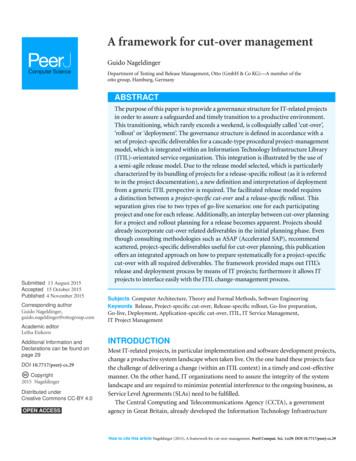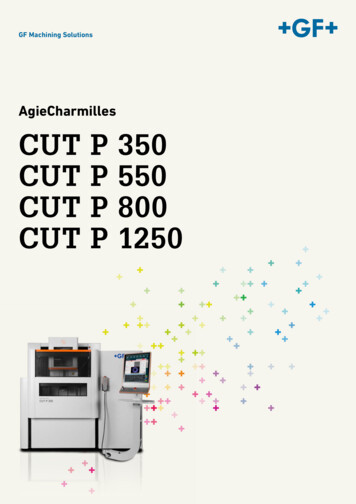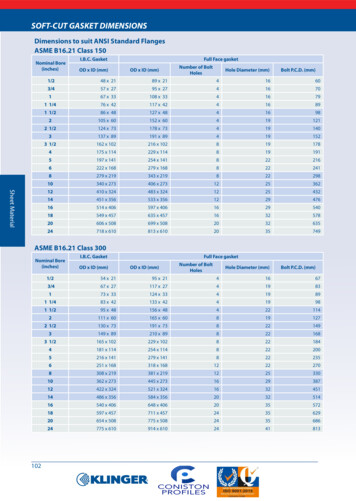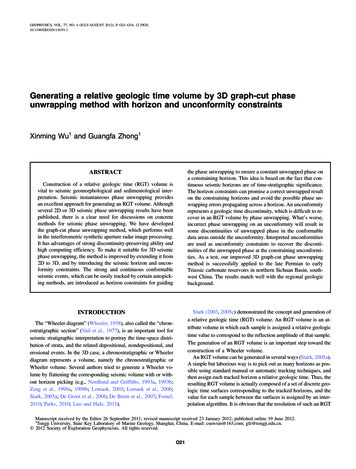
Transcription
A framework for cut-over managementGuido NageldingerDepartment of Testing and Release Management, Otto (GmbH & Co KG)—A member of theotto group, Hamburg, GermanyABSTRACTSubmitted 13 August 2015Accepted 15 October 2015Published 4 November 2015Corresponding authorGuido Nageldinger,guido.nageldinger@ottogroup.comThe purpose of this paper is to provide a governance structure for IT-related projectsin order to assure a safeguarded and timely transition to a productive environment.This transitioning, which rarely exceeds a weekend, is colloquially called ‘cut-over’,‘rollout’ or ‘deployment’. The governance structure is defined in accordance with aset of project-specific deliverables for a cascade-type procedural project-managementmodel, which is integrated within an Information Technology Infrastructure Library(ITIL)-orientated service organization. This integration is illustrated by the use ofa semi-agile release model. Due to the release model selected, which is particularlycharacterized by its bundling of projects for a release-specific rollout (as it is referredto in the project documentation), a new definition and interpretation of deploymentfrom a generic ITIL perspective is required. The facilitated release model requiresa distinction between a project-specific cut-over and a release-specific rollout. Thisseparation gives rise to two types of go-live scenarios: one for each participatingproject and one for each release. Additionally, an interplay between cut-over planningfor a project and rollout planning for a release becomes apparent. Projects shouldalready incorporate cut-over related deliverables in the initial planning phase. Eventhough consulting methodologies such as ASAP (Accelerated SAP), recommendscattered, project-specific deliverables useful for cut-over planning, this publicationoffers an integrated approach on how to prepare systematically for a project-specificcut-over with all required deliverables. The framework provided maps out ITIL’srelease and deployment process by means of IT projects; furthermore it allows ITprojects to interface easily with the ITIL change-management process.Subjects Computer Architecture, Theory and Formal Methods, Software EngineeringKeywords Release, Project-specific cut-over, Release-specific rollout, Go-live preparation,Go-live, Deployment, Application-specific cut-over, ITIL, IT Service Management,IT Project ManagementAcademic editorLetha EtzkornAdditional Information andDeclarations can be found onpage 29DOI 10.7717/peerj-cs.29Copyright2015 NageldingerDistributed underCreative Commons CC-BY 4.0OPEN ACCESSINTRODUCTIONMost IT-related projects, in particular implementation and software development projects,change a productive system landscape when taken live. On the one hand these projects facethe challenge of delivering a change (within an ITIL context) in a timely and cost-effectivemanner. On the other hand, IT organizations need to assure the integrity of the systemlandscape and are required to minimize potential interference to the ongoing business, asService Level Agreements (SLAs) need to be fulfilled.The Central Computing and Telecommunications Agency (CCTA), a governmentagency in Great Britain, already developed the Information Technology InfrastructureHow to cite this article Nageldinger (2015), A framework for cut-over management. PeerJ Comput. Sci. 1:e29; DOI 10.7717/peerj-cs.29
Library (ITIL) at the end of the 1980s. The latest update of ITIL V3 was published in2011 which is frequently referenced as ITIL 2011. Is it still relevant? Yes, because it helpsbring order to IT chaos. Proehl et al. (2013) analyzed 255 articles in the field of IT ServiceManagement. They also confirmed the work by Shahsavarani & Ji (2011). Both studiesfound a growing number of published papers dealing with the development of concepts,constructs, models, methods and implementations for theory development. Performanceissues in IT Service Management, justifications, and IT Infrastructure Library topics areamong the most popular topics of research. Only a few articles have used or developedtheories. Marrone et al. (2014) found organizations adopting ITIL implemented moreoperational level processes than the tactical/strategic level processes. The study utilizes 623survey responses from the UK, USA, DACH (German-speaking countries) and Australia.ITIL is rarely seen in isolation and current research focuses on the integration with ITgovernance standards, such as ISO/IEC 38500 and other methodologies, such as COBIT,PRINCE2 and the ISO2700x-family (Tanovic & Orucevic , 2012; Shivashankarappa et al.,2012; Jäntti et al., 2014; Larsson, Rusu & Aasi, 2015).ITIL’s release and deployment management processes are demanding. Jokela & Jäntti(2012) as well as Lahtela & Jaentti (2011) identified within their case studies the followingcommon challenges: no existing process for product portfolio release and deployment management lack of communication unclear release and deployment management and/or product portfolio managementprocess roles lack of resources and time for product portfolio integration, testing and reviewing existing models and practices are not suitable for agile software development uncertainty about of the contents of release packages high release distribution frequency different and tailored release packages the change management is not up to date and no existing service catalog.The project-specific cut-over, as defined in more detail below, requires detailed planning,many meetings and several agreements with all stakeholders involved. Which questionsneed to be addressed? Here are just some of them: How should the project outcomes be transferred to operation? Which scenario provides the best compromise between time, cost and risk? What happens if the cut-over fails? How can the previous system condition or version be reinstalled in case cut-over fails? How can we ensure that projects start early enough, with all the necessary preparationwork?Nageldinger (2015), PeerJ Comput. Sci., DOI 10.7717/peerj-cs.292/31
How can cut-over activities be aligned within an IT service organization? How do we measure the success of the cut-over–and how can we maximise it?Unfortunately, answers and activities associated with these cut-over related topics arefrequently addressed too late, probably because the cut-over is one of the final steps inprojects and can therefore be hidden for a long time. If a cut-over and its associateddeliverables are not integrated within the overall Project Plan then projects are at risk ofbeing delivered too late. For this reason, there is an urgent business need to govern projectsin such a manner that they do not forget to cover cut-over related items. So, which itemsshould projects cover?This question and many others are addressed by a ‘framework for deploymentmanagement’ as referred to below in this document. The purpose of this paper is to providea methodology which assures a robust and timely go-live for projects.An itemised objective overview: to list the key deliverables projects need to provide in order to assure a timely and safego-live to illustrate how these deliverables can be integrated within the ITIL release anddeployment process to look into different deployment types, which this paper refers to as (a) project-specificcut-over, (b) application-specific cut-over and (c) release-specific rollout along with thetimeframes and timepoints involved, and lastly to present a framework which enables an IT-service organization to transition a projectto a productive environment.The scope of the deployment framework introduced is required to be applicable within an Information Technology Infrastructure Library (ITIL)orientated service organization, and to extend commonly facilitated project-management methodologies.As with most management practices, there are always more ways to achieve similar resultswith other approaches. However, in order to examine and establish good managementpractice, these methodologies need to be published to facilitate comparison. Theframework published here is just one of many potential options. It illustrates howdeployment activities can be harmonised with commonly facilitated IT projects as wellas quality-management practices, and integrated in an ITIL environment.Even though it is possible to take advantage of the deployment framework presentedhere without ITIL, many companies have adopted ITIL recommendations and bestpractices and are organized in a service-orientated manner. IT projects are thereforeunlikely to exist in isolation and are more likely to be embedded in a service-orientatedmanner. ITIL is known to be generic and by itself is not complete. Its purpose is not toprovide advice on how to implement IT Service Management processes. Instead it requiresintegration with other disciplines such as project management and quality management.Nageldinger (2015), PeerJ Comput. Sci., DOI 10.7717/peerj-cs.293/31
The framework presented here in the form of an illustrative case study arose duringmy consultancy work and has been implemented for some applications within theDepartment of Testing and Release Management of Otto (GmbH & Co KG) which is amember of the otto group. It is not a hypothetical model. Projects which wish to cut-overin form of a release-specific rollout are requested to comply with this framework. Withinevery release between 15 to 25 projects are participating. Six release-specific rollouts areconducted every year. Even though consulting methodologies such as ASAP (AcceleratedSAP) recommend scattered project-specific deliverables useful for Cut-over Planning,this publication offers an integrated approach on how to systematically prepare for aproject-specific cut-over with all required deliverables. The framework provided extendsthe ITIL release and deployment process by means of IT projects and allows IT projects tointerface easily with the ITIL change-management process.The activities of the otto group, with its headquarters located in Hamburg, Germany,are grouped into three main business areas: (i) Multichannel Retail, (ii) Financial Servicesand (iii) Service. This structure is consistently reflected in the group’s activities alongthe retail value chain, in Logistics for instance. In the year 2014/15, the Group generatedconsolidated revenue of more than 12 billion euros and employed about 54,000 staffworldwide.PROJECT-SPECIFIC CUT-OVER VERSUS RELEASESPECIFIC ROLLOUTITIL is often facilitated as a checklist. With regard to the release and deployment process, itconsists of the following steps (Rance, 2011): plan and prepare a release build and test a release plan and prepare deployment conduct deployment conduct review, and provide early-life support.Due to its generic nature and the need to interface with other disciplines, IT-serviceorganizations implement these steps quite differently. The variability of implementationoptions may be caused by different interpretations of the term ‘release’, which is also relatedto the term ‘change’. How does ITIL define these terms?The term ‘release’ is defined as: “One or more changes to an IT service that are built,tested and deployed together. A single release may include changes to hardware, software,documentation, processes and other components.” (AXELOS, 2011).The term ‘change’ is defined as: “The addition, modification or removal of anything thatcould have an effect on IT services. The scope should include changes to all architectures,processes, tools, metrics and documentation, as well as changes to IT services and otherconfiguration items.” (AXELOS, 2011).Nageldinger (2015), PeerJ Comput. Sci., DOI 10.7717/peerj-cs.294/31
Figure 1 Example of a semi-agile release model. Example of a semi-agile release model with its projectand rollout view and relation to ITIL’s Application Management, Problem & Incident Management aswell as Change Management.In order to safeguard the related system landscape as well as associated services,conventions need to be outlined on the practical arrangement and organization ofrelease-related changes. Here, the term ‘release-model’ is facilitated for a set of rules andconventions used to bundle and organize a release.Figure 1 illustrates a semi-agile release model, which is used within this publicationas an example to address some dependencies (Nageldinger, 2015). This release model iscalled ‘semi-agile’ here because it consists of an agile section and a release phase, whichfollows a classical sequential pattern (cascade model). During the agile period, phasesbetween projects are non-clocked. Project phases which fall within the agile period relateto the Project Planning, design and realization section, and can be conducted in sprints.Once these projects participate in an integration test, then their phases need to be clocked.Independently of which release model is facilitated, the release phase will most likelyconsist of (i) an entry gate, (ii) technical and business-related integration tests with theiracceptance procedures, and (iii) the release-specific rollout (see Fig. 2).Let us now look at the deployment types. In case the bundling of projects is foreseenby the release model, such as in the one presented here, then we encounter deploymentrelated to the release as well as deployment related to participating projects. ITILdoes not distinguish between these. Here, the term ‘deployment’ (AXELOS, 2011) isdefined as “an activity responsible for movement of new or changed hardware, software,documentation, process etc. to the live environment. Deployment is part of the release anddeployment management process.” It can probably be argued that such a distinction isunnecessary, since all bundled projects are to be deployed in the same time slot. However,the project-specific deployment and its associated preparation work are owned by theNageldinger (2015), PeerJ Comput. Sci., DOI 10.7717/peerj-cs.295/31
Figure 2 Release phase and rollout window. Illustration of the release phase and the positioning of therollout window.Project Manager and, in the case of larger projects, by a designated Cut-over Manager.According to ITIL the Release and Deployment Manager owns the release and its associateddeployment.ITIL’s definition of ‘deployment’ lacks conceptual clarity. This is because if we look onlyat the movement of software to the live environment then we also need to distinguishbetween the actual movement and its use when the software is ‘switched on’. This isnecessary if legal changes come into effect at a specific point in time, for example, butthe software is required to be moved to the live environment beforehand. For the purposesof this paper the term ‘deployment’ from now on is solely used to refer to the movementof software to the live environment, which is commonly conducted within a restrictedtimeframe. The term ‘point-of-use’ is facilitated to account for the point in time in whichthe software is ‘switched on’.In order to safeguard our system landscape and associated services we need to monitorboth the deployment (timeframe) and point(s)-of-use (point in time). In the context of arelease, one deployment and potentially more points-of-use are scheduled. This aspect iselaborated further below in the discussion of the release-change.Besides the participating projects, a release additionally includes service packs (a phraseused for minor upgrades), bug fixes and smaller system-related features. These non-projectelements are usually governed by separate changes. All ingredients of a release shouldprovide the option of independent transitioning to the productive environment. If thisoption is not provided, then projects or non-project elements cannot easily be excludedfrom the release if they fail the integration test. Smaller projects are likely to be bundledin form of a release, and then transitioned to a productive environment in form of arelease-specific rollout. Major IT implementation projects are preferably transitioned to aproductive environment independently, in order to reduce complexity.Nageldinger (2015), PeerJ Comput. Sci., DOI 10.7717/peerj-cs.296/31
The term ‘project-specific cut-over’ defines the transition of a project to a productiveenvironment. It relates to the project as a whole and includes the software deployment andits point of use. The actual timeframe associated with the project-specific cut-over is calledthe ‘cut-over window’. The ‘release-specific rollout’ defines the collective transition ofbundled projects to a productive environment. In the same way, the associated timeframeis called the ‘Rollout Window’ (Nageldinger, 2014).Frequently, projects communicate what is frequently called a ‘go-live date’ on theiroverall project chart. In view of the reasons given above, this could mean (i) end of thesoftware deployment, (ii) end of cut-over window, which relates to the transitioning of thewhole project, or (iii) point-of-use. It is therefore recommended to question what exactlythis date refers to.Beside the project-specific cut-over and the release-specific rollout we are most likely toface a third transitioning aspect, here called the ‘application-specific cut-over’: this relatesto a specific system or application and mainly covers approaches related to maintenanceor upgrades. It differs from the project-specific cut-over in that it consists of canonical(i.e., reoccurring with every rollout) activities and tasks. The deployment of service packscan be organized canonically, for example.Within an SAP context the term ‘rollout’ is frequently associated with a so-called‘template approach’. In this, the core configuration is embedded within a reusable templateand the country-specific characteristics are added separately in the form of a localconfiguration (SAP, 2009). SAP’s usage of the term ‘rollout’ is quite similar to the definitionprovided here and its associated release context. This is because the release-specific rolloutalso consists of reoccurring activities, here referred to as “application-specific cut-over”,which is similar to SAP’s template approach. The project-specific cut-over activities,which are non-reoccurring, may be considered in the same way as SAP’s country-specificcharacteristics.The Cut-over Schedule is a list of tasks and activities required in order to conduct thecut-over. It differs from the ordinary overall project schedule as it only focuses on tasksand activities within the cut-over window, of short duration and lasting only for a coupleof hours or a weekend. The Cut-over Schedule is created by duration-based schedulingtechniques. Additionally, it contains a list of prerequisites, such as the delivery of trainingcourses and the installation of printers etc. These prerequisites need to be completed beforethe actual cut-over can be conducted and are part of the overall project schedule. TheCut-over Schedule does not relate to the post go-live phase. For this objective projects needto have a separate plan, which for example addresses aspects of support, data-conservationand accounting closure procedures.Besides the Cut-over Schedule the Cut-over Plan contains a variety of other deliverables,in the same way as a project-management plan, which are further elaborated below. Keyelements of a Cut-over Schedule are for example termination points, frequently called‘points-of-return’ (POR). Theses PORs aim to trigger activities used (i) to restore theinitial condition or (ii) incrementally fall back to a previous POR. The last POR is referredto as the ‘point-of-no-return’ (PONR). The PONR does not always fall within the cut-overNageldinger (2015), PeerJ Comput. Sci., DOI 10.7717/peerj-cs.297/31
Figure 3 Visualization of the cut-over window.window. The Fallback Concept is the name of a document used to describe activities whichare potentially necessary at these PORs, in case the system needs to be rolled back to aprevious state or even its initial state. If the cut-
the ITIL release and deployment process by means of IT projects and allows IT projects to interface easily with the ITIL change-management process. The activities of the otto group, with its headquarters located in Hamburg, Germany, are grouped into three main business areas: (i) Multic











